![]()
![]()
![]()
Use LEFT and RIGHT arrow keys to navigate between flashcards;
Use UP and DOWN arrow keys to flip the card;
H to show hint;
A reads text to speech;
39 Cards in this Set
- Front
- Back
- 3rd side (hint)
|
Avoid unnecessary movement |
Movement catches the eye, use concealment, do not expose reflective things, stay in the shade, distort outlines |
|
|
|
Search field of View: off-center |
Use this method during nigh time to avoid night blind spot, look at an object 6 to 10 degrees off rather than directly at it |
|
|
|
Search field of view: scanning |
Reduce confusing visually illusions, look from right to left or left to right using a slow, regular scanning movement. |
|
|
|
Search field of view: Strip |
Look at ground nearest you, search a narrow strip 50 meters or less deep, going right to left parallel to your front, then left to right, slightly overlapping first strip, continuing until you’ve searched entire field of view |
|
|
|
Preserve Night vision |
Keep one eye closed to preserve night vision with entering temporary lighted area, use red lights, avoid alcohol, nicotine, long exposure to sunlight, and fatigue |
|
|
|
Enhance hearing |
Open mouth Remove helmet Place ear close to the ground to hear walking people and moving vehicles |
|
|
|
Enemy Intel info Report |
Size/strength Activity or action Location and direction on movement Unit Identification Time of observation Equipment and weapons |
SALUTE |
|
|
Operation Order |
Five Paragraph Order: Situation Mission Execution Administration and Logistics Command and signal |
SMEAC |
|
|
Situation |
Environment Enemy Forces Friendly forces Attachments and detachments |
|
|
|
Mission |
Clear and concise statement of the task that the patrol must accomplish |
|
|
|
Execution |
Concept of Operations- patrol leader’s brief summary of the tactical plan the patrol is to execute |
|
|
|
Administration and Logistics |
Information about rations and ammunition; location of distribution point, corpsman, and aid station; handling of prisoners of war; and other admin and supply matters |
|
|
|
Command and signal |
Special instructions on communications, prearranged signals, passwords etc location of patrol leader, assistance patrol leader, and subordinate leaders |
|
|
|
Column Formation |
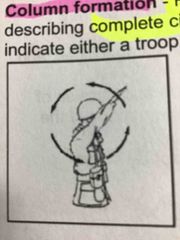
Raise either arm vertically, drop to rear, creating large circles |
|
|
|
Echelon right/left |

Extend arms out, one 45 degrees below the horizontal, palms out. Lower arm indicates direction |
|
|
|
Skirmishes left/right |
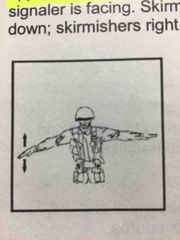
Raise both arms, palms down, move in desired direction to indicate direction, indicate fire team skirmishes by moving left or right hand up and down |
|
|
|
Wedge formation |
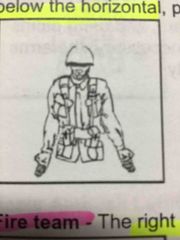
Extend both arms down at 45 degrees, palms out |
|
|
|
Fire Team |
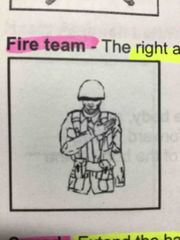
Right arm diagnosed across chest |
|
|
|
Squad |
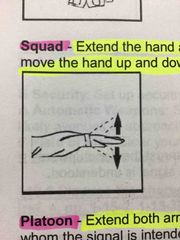
Extend hand and arm toward the quad leader and move hand up and down, arm still |
|
|
|
Platoon |
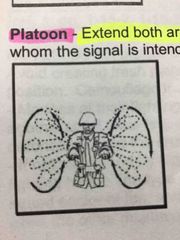
Extend both arms forward, palms down and make large circles |
|
|
|
Close up |
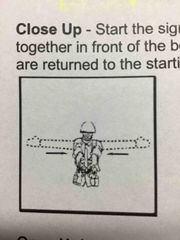
Extend both arms horizontally, palms forward, and bring palms together |
|
|
|
Open up/extend |

Extend arms forward, palms together, and spread arms apart horizontally |
|
|
|
Halt/stop |
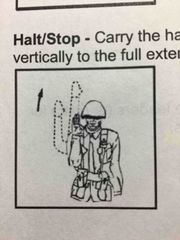
Hand to shoulder, palm out, thrust. Arm upward and hold |
|
|
|
Dismount/take cover |
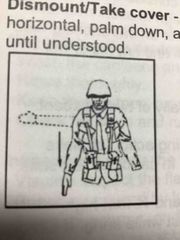
Extend one or both arms out, palm down at 45 degrees and lower to side |
|
|
|
Hasty ambush left/right |
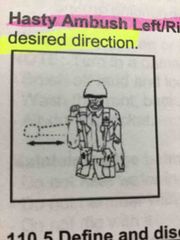
Raise first to shoulder and thrust several times out in desired direction |
|
|
|
Constructing a fighting position |
Security Automatic Weapons Field of Fire Entrenchment |
SAFE |
|
|
Characteristics of a fighting position |
Do not disturb natural concealment Avid creating new paths Dig fighting holes to protect from fire, shell fragments, bombings, effects of nuclear bombs, and crushing of tanks Squad leader or higher designates which type of fighting hole to use |
|
|
|
Individual fighting position |
As small as practicable, exposing minimally to enemy fire, wide enough to accommodate shoulders of a man sitting on fire step, long enough to permit use of entrenching tool, 4 feet deep to the fire step |
|
|
|
Two-man fighting position |
Essentially two adjacent one-man holes. Gives protection from crushing of tanks if occupant crouches, pile spit as parapet Offers somewhat less protection from tanks due to length, and against strafing, bombing, and shell fragments Allows continued observation, mutual assistance and reassurance, and redistribution of ammo |
|
|
|
Armor Protection Level System |
Defines body armor protection levels from 0 to 3 Determined by operating commanders at lieutenant colonel or higher |
APLES |
|
|
APLES levels |
0 - No armor 1 - Vest with soft armor only 2 - vest with front and back hard armor plates 3 - vest with front, back, and side hard armor plates |
|
|
|
Camouflage |
Anything you can use to keep yourself, your equipment, and your position fro looking like what they are |
|
|
|
Cover |
Anything that gives protection from bullets, fragments, of exploding rounds, flame, nuclear effects, and CBRN agents. Can also conceal you from the enemy |
|
|
|
Concealment |
Anything that hides you from enemy observation. Does not protect you from enemy fire |
|
|
|
Individual movement methods |
High crawl - faster, body pff ground Low crawl - speed not essential, body flat Back crawl - headfirst on your back Rush - run forward quickly, zigzag, hit the deck Night walk - heel toe, keeping quiet Creeping - all fours, keeping quiet Crossing a wall - recon, roll over, keep low |
|
|
|
CASEVAC Priorities |
Priority 1 - Urgent: emergent case, exam witching 2 hours to safe life, limb, or eyesight 1A - Surgical intervention Priority 2 - Priority - requires prompt medical care, evac within 4 hours to prevent condition deterioration Priority 3 - Routine: Condition not expected to deteriorate, evac withing 24 hours Priority 4 - Convenience: Mecca is a matter or convenience rather than necessity |
|
|
|
Lading Zones? |
??????????????? |
|
|
|
Difference in Nine line War and Peace |
Line 6 - Peace time: number and type of injury/illness War: security of site Line 9 - Peace: description of terrain War: NBC contamination if applicable Security of site: Non-war conditions, safety of military and civilian personnel outweighs need for security and clear text transmittals are authorized. During wartime, transmittals are transmitted by secure means only and evac of pts is weighed against unit survival |
|
|
|
Full 9 Line |
1 - location of pickup site 2 - Radio Frequency, call sign, and suffix 3 - number of pts by precedence/priority 4 - pencils Equipment required 5 - number of pts by type 6- security of pickup site/# and type of injury 7 - method of marking site 8 - pt nationalality and status (Mil or Civ) 9 - NBC Contamination / terrain description |
|

